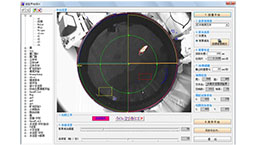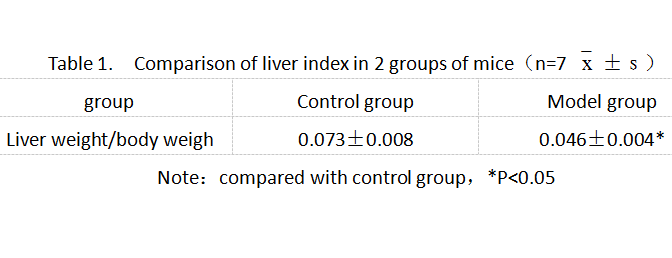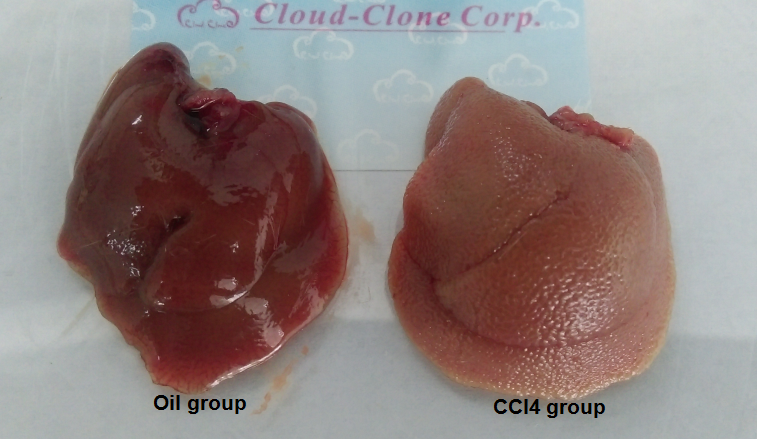Mouse Model for Hepatic Fibrosis (HF)
Liver Fibrosis
- Product No.DSI520Mu01
- Organism SpeciesMus musculus (Mouse) Same name, Different species.
- Prototype SpeciesHuman
- SourceCCL4 induced Hepatic Fibrosis
- Model Animal StrainsBalb/c (SPF), healthy, male, body weight 18g-20g
- Modeling GroupingRandomly divided into six group: Control group, Model group, Positive drug group and Test drug group (three doses)
- Modeling Period6 weeks
- Modeling MethodSubcutaneous injection of the 20% CCl4 of the oil solution (CCl4: olive oil =1:4) to the mice( 5ml/kg), 3 times every week,last for six weeks. Olive oil are injected the control group mice. Normal diet, observation of animal activities, mental status and diet, the weight of mice before and after the experiment.
After 6W, weighing the mice, sodium intraperitoneal injection of anesthesia mice, pick the eye to take blood, 4℃, 3000r, 10 minutes centrifuge to extract serum, stored at -80℃. And get the left liver tissue 1.5cm x 1 cm x 0.2 cm, fixed in 10% neutral buffered formalin, embedded in paraffin; the remaining tissues are stored in liquid nitrogen or -80℃. - ApplicationsDisease model
- Downloadn/a
- UOM Each case
- FOB
US$ 196
For more details, please contact local distributors!
Model Evaluation
1. General observation: the activity of mice injected with CCl4 gradually decreased ,with prolongation of medication, listlessness, shaggy dull;
CCl4 group,liver with the surrounding tissue adhesion significantly, the liver edge round meal, liver surface and section showed diffuse small nodules.
2. liver index changes: to take the liver, weight the liver and calculate the liver index,
liver index = liver weight / body weight, CCl4 group of mice liver are significantly lower than the control group.
3. liver function index:
Liver function indexes in mice serum were detected by ELISA Kit: alanine aminotransferase (ALT), aspartate aminotransferase (AST), total bilirubin (TBL), and albumin (ALB).
The results showed that the content of ALT, AST and TBL in the serum of CCl4 group is significantly higher than that of the control group, the content of ALB is significantly lower than that of the control group.
Pathological Results
Take the left lobe of liver, 10% formalin fixation and paraffin embedded sections, after HE and Masson staining in the electron microscope observation of liver inflammation and fibrosis degree. According to the following criteria to judge the degree of liver fibrosis:
Hepatitis lesions inflammatory activity is divided into 4 levels according to:
"-" exchange near the portal area and hepatic lobules without inflammation;
"+" liver cell degeneration does not exceed 1/2 of the radius of the hepatic lobules and portal inflammation, leaflets in a small number of liver cell degeneration or a spotty necrosis;
"+ +" liver cell change range than liver lobule radius 1/2, periportal inflammatory cell infiltration and more degeneration of hepatocytes is piecemeal necrosis;
"+ + +" liver cell degeneration range more than two thirds of the radius of the lobule, the portal area is severe piecemeal necrosis and liver cells to piecemeal and bridging necrosis mainly.
Liver fibrosis according to severity is divided into four level:
"-" no liver fibrosis;
"+" collagen fiber increased on the portal area, but no fibrous septa formation;
"+ +" the portal area formed around the incomplete fibrous septa are not connected to each other.
"+ + +" lobular structure disorders and the fibrous septa obvious, segmentation of the liver parenchyma.
Cytokines Level
After liver injury, the expression of TNFα, IFNγ, IL-2, IL-6, ICAM1 and other cytokines in serum is significantly increased, which could be detected by ELISA method.
Statistical Analysis
SPSS software is used for statistical analysis, measurement data to mean ± standard deviation (x ±s), using t test and single factor analysis of variance for group comparison, P<0.05 indicates there was a significant difference, P<0.01 indicates there are very significant differences.
GIVEAWAYS
INCREMENT SERVICES
-
 Tissue/Sections Customized Service
Tissue/Sections Customized Service
-
 Serums Customized Service
Serums Customized Service
-
 Immunohistochemistry (IHC) Experiment Service
Immunohistochemistry (IHC) Experiment Service
-
 Small Animal In Vivo Imaging Experiment Service
Small Animal In Vivo Imaging Experiment Service
-
 Small Animal Micro CT Imaging Experiment Service
Small Animal Micro CT Imaging Experiment Service
-
 Small Animal MRI Imaging Experiment Service
Small Animal MRI Imaging Experiment Service
-
 Small Animal Ultrasound Imaging Experiment Service
Small Animal Ultrasound Imaging Experiment Service
-
 Transmission Electron Microscopy (TEM) Experiment Service
Transmission Electron Microscopy (TEM) Experiment Service
-
 Scanning Electron Microscope (SEM) Experiment Service
Scanning Electron Microscope (SEM) Experiment Service
-
 Learning and Memory Behavioral Experiment Service
Learning and Memory Behavioral Experiment Service
-
 Anxiety and Depression Behavioral Experiment Service
Anxiety and Depression Behavioral Experiment Service
-
 Drug Addiction Behavioral Experiment Service
Drug Addiction Behavioral Experiment Service
-
 Pain Behavioral Experiment Service
Pain Behavioral Experiment Service
-
 Neuropsychiatric Disorder Behavioral Experiment Service
Neuropsychiatric Disorder Behavioral Experiment Service
-
 Fatigue Behavioral Experiment Service
Fatigue Behavioral Experiment Service
-
 Nitric Oxide Assay Kit (A012)
Nitric Oxide Assay Kit (A012)
-
 Nitric Oxide Assay Kit (A013-2)
Nitric Oxide Assay Kit (A013-2)
-
 Total Anti-Oxidative Capability Assay Kit(A015-2)
Total Anti-Oxidative Capability Assay Kit(A015-2)
-
 Total Anti-Oxidative Capability Assay Kit (A015-1)
Total Anti-Oxidative Capability Assay Kit (A015-1)
-
 Superoxide Dismutase Assay Kit
Superoxide Dismutase Assay Kit
-
 Fructose Assay Kit (A085)
Fructose Assay Kit (A085)
-
 Citric Acid Assay Kit (A128 )
Citric Acid Assay Kit (A128 )
-
 Catalase Assay Kit
Catalase Assay Kit
-
 Malondialdehyde Assay Kit
Malondialdehyde Assay Kit
-
 Glutathione S-Transferase Assay Kit
Glutathione S-Transferase Assay Kit
-
 Microscale Reduced Glutathione assay kit
Microscale Reduced Glutathione assay kit
-
 Glutathione Reductase Activity Coefficient Assay Kit
Glutathione Reductase Activity Coefficient Assay Kit
-
 Angiotensin Converting Enzyme Kit
Angiotensin Converting Enzyme Kit
-
 Glutathione Peroxidase (GSH-PX) Assay Kit
Glutathione Peroxidase (GSH-PX) Assay Kit
-
 Cloud-Clone Multiplex assay kits
Cloud-Clone Multiplex assay kits
| Catalog No. | Related products for research use of Mus musculus (Mouse) Organism species | Applications (RESEARCH USE ONLY!) |
| DSI520Mu01 | Mouse Model for Hepatic Fibrosis (HF) | Disease model |
| DSI520Mu02 | Mouse Model for Hepatic Fibrosis (HF) | n/a |







